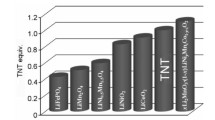Abstract
This article deals with reactions occurring under the action of active particles formed during the flash of a corona electric discharge between a solid electrode and the surface of a liquid—electrochemical reactions without an electrode. Reactions take place in a thin surface layer of water, where there are no electrodes, so the reactions are called electrodeless. The electrodes are used only to excite the reaction zone and do not directly participate in the reaction. The oxidation of organic compounds to carbon dioxide and water occurs in an electrodeless reaction.



Similar content being viewed by others
REFERENCES
Hickling, A., Electrochemical processes in glow discharge at the gas–solution interface, Modern Aspects of Electrochemistry, London: Butterworths, 1971, no. 6, p. 329.
Muhammad Arif Malik, Abdul Ghaffar, and Salman Akbar Malik, Water purification by electrical discharges, Plasma Sources Sci. Technol., 2001, vol. 10, p. 82.
Piskarev, I.M., Conditions for the initiation of reactions in a liquid by active particles from the gas phase, Zh. Fiz. Khim., 1998, vol. 72, no. 11, p. 1976.
Trichel, G.W., Phys. Rev., 1938, vol. 54, p. 1078.
Akishev, Yu.S., Kochetov, I.V., Loboiko, A.I., and Napartovich, A.P., Numerical simulations of Trichel pulses in a negative corona in air, Plasma Phys. Rep., 2002, vol. 28, no. 12, s. 1049.
Aristova, N.A. and Piskarev, I.M., Characteristic features of reactions initiated by a flash corona discharge, Tech. Phys., 2002, vol. 47, no. 10, p. 1246.
Piskarev, I.M., Oxidation of phenol by OH, H, O, and O3 particles formed in an electric discharge, Kinet. Katal., 1999, vol. 40, no. 4, p. 505.
Aristova, N.A., Karpel Vel, L.N., and Piskarev, I.M., Degradation of formic acid in different oxidative processes, High Energy Chem., 2002, vol. 36, no. 3, p. 197.
Piskarev, I.M., A model of reactions in a corona discharge in the O2(g)–H2O system, Russ. J. Phys. Chem., 2000, vol. 74, no. 3, p. 464.
Piskarev, I.M., Reactions in air and nitrogen in the plasma of a corona discharge between the surface of water and an electrode, Russ. J. Phys. Chem., 2001, vol. 75, no. 11, p. 1832.
Author information
Authors and Affiliations
Corresponding author
Ethics declarations
The author declares that she has no conflict of interest.
About this article
Cite this article
Rzayeva, S.V. Features of Electrodeless Electrochemical Reactions. Surf. Engin. Appl.Electrochem. 59, 590–594 (2023). https://doi.org/10.3103/S1068375523050150
Received:
Revised:
Accepted:
Published:
Issue Date:
DOI: https://doi.org/10.3103/S1068375523050150




